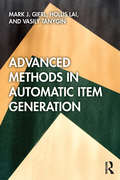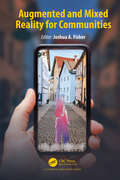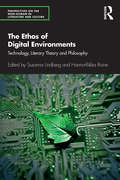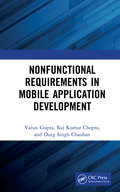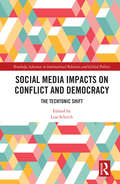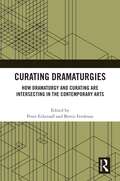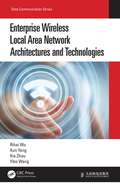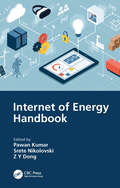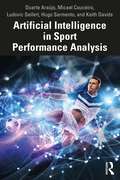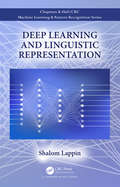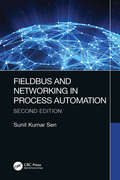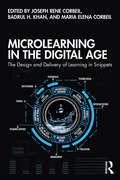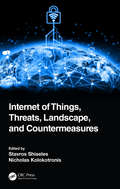- Table View
- List View
Advanced Methods in Automatic Item Generation
by Mark J. Gierl Hollis Lai Vasily TanyginAdvanced Methods in Automatic Item Generation is an up-to-date survey of the growing research on automatic item generation (AIG) in today’s technology-enhanced educational measurement sector. As test administration procedures increasingly integrate digital media and Internet use, assessment stakeholders—from graduate students to scholars to industry professionals—have numerous opportunities to study and create different types of tests and test items. This comprehensive analysis offers thorough coverage of the theoretical foundations and concepts that define AIG, as well as the practical considerations required to produce and apply large numbers of useful test items.
Advanced Methods in Automatic Item Generation
by Mark J. Gierl Hollis Lai Vasily TanyginAdvanced Methods in Automatic Item Generation is an up-to-date survey of the growing research on automatic item generation (AIG) in today’s technology-enhanced educational measurement sector. As test administration procedures increasingly integrate digital media and Internet use, assessment stakeholders—from graduate students to scholars to industry professionals—have numerous opportunities to study and create different types of tests and test items. This comprehensive analysis offers thorough coverage of the theoretical foundations and concepts that define AIG, as well as the practical considerations required to produce and apply large numbers of useful test items.
Augmented and Mixed Reality for Communities
by Joshua A. FisherUsing mixed and augmented reality in communities is an emerging media practice that is reshaping how we interact with our cities and neighbors. From the politics of city hall to crosswalks and playgrounds, mixed and augmented reality will offer a diverse range of new ways to interact with our communities. In 2016, apps for augmented reality politics began to appear in app stores. Similarly, the blockbuster success of Pokémon Go illustrated how even forgotten street corners can become a magical space for play. In 2019, a court case in Milwaukee, Wisconsin, extended first amendment rights to augmented reality. For all the good that these emerging media provide, there will and have been consequences. Augmented and Mixed Reality for Communities will help students and practitioners navigate the ethical design and development of these kinds of experiences to transform their cities. As one of the first books of its kind, each chapter in the book prepares readers to contribute to the Augmented City. By providing insight into how these emerging media work, the book seeks to democratize the augmented and mixed reality space.Authors within this volume represent some of the leading scholars and practitioners working in the augmented and mixed reality space for civic media, cultural heritage, civic games, ethical design, and social justice. Readers will find practical insights for the design and development to create their own compelling experiences. Teachers will find that the text provides in-depth, critical analyses for thought-provoking classroom discussions.
Augmented and Mixed Reality for Communities
by Joshua A. FisherUsing mixed and augmented reality in communities is an emerging media practice that is reshaping how we interact with our cities and neighbors. From the politics of city hall to crosswalks and playgrounds, mixed and augmented reality will offer a diverse range of new ways to interact with our communities. In 2016, apps for augmented reality politics began to appear in app stores. Similarly, the blockbuster success of Pokémon Go illustrated how even forgotten street corners can become a magical space for play. In 2019, a court case in Milwaukee, Wisconsin, extended first amendment rights to augmented reality. For all the good that these emerging media provide, there will and have been consequences. Augmented and Mixed Reality for Communities will help students and practitioners navigate the ethical design and development of these kinds of experiences to transform their cities. As one of the first books of its kind, each chapter in the book prepares readers to contribute to the Augmented City. By providing insight into how these emerging media work, the book seeks to democratize the augmented and mixed reality space.Authors within this volume represent some of the leading scholars and practitioners working in the augmented and mixed reality space for civic media, cultural heritage, civic games, ethical design, and social justice. Readers will find practical insights for the design and development to create their own compelling experiences. Teachers will find that the text provides in-depth, critical analyses for thought-provoking classroom discussions.
The Ethos of Digital Environments: Technology, Literary Theory and Philosophy (Perspectives on the Non-Human in Literature and Culture)
by Susanna Lindberg Hanna-Riikka RoineWhile self-driving cars and autonomous weapon systems have received a great deal of attention in media and research, the general requirements of ethical life in today’s digitalizing reality have not been made sufficiently visible and evaluable. This collection of articles from both distinguished and emerging authors working at the intersections of philosophy, literary theory, media, and technology does not intend to fix new moral rules. Instead, the volume explores the ethos of digital environments, asking how we can orient ourselves in them and inviting us to renewed moral reflection in the face of dilemmas they entail. The authors show how contemporary digital technologies model our perception, narration as well as our conceptions of truth, and investigate the ethical, moral, and juridical consequences of making public and societal infrastructures computational. They argue that we must make the structures of the digital environments visible and learn to care for them.
The Ethos of Digital Environments: Technology, Literary Theory and Philosophy (Perspectives on the Non-Human in Literature and Culture)
by Susanna LindbergWhile self-driving cars and autonomous weapon systems have received a great deal of attention in media and research, the general requirements of ethical life in today’s digitalizing reality have not been made sufficiently visible and evaluable. This collection of articles from both distinguished and emerging authors working at the intersections of philosophy, literary theory, media, and technology does not intend to fix new moral rules. Instead, the volume explores the ethos of digital environments, asking how we can orient ourselves in them and inviting us to renewed moral reflection in the face of dilemmas they entail. The authors show how contemporary digital technologies model our perception, narration as well as our conceptions of truth, and investigate the ethical, moral, and juridical consequences of making public and societal infrastructures computational. They argue that we must make the structures of the digital environments visible and learn to care for them.
Nonfunctional Requirements in Mobile Application Development
by Varun Gupta Durg Singh Chauhan Raj Kumar ChopraNonfunctional Requirements in Mobile Application Development is an empirical study that investigates how nonfunctional requirements--as compared with functional requirements--by the software engineers during mobile application development. The book empirically analyzes the contribution of nonfunctional requirements to project parameters such as cost, time, and quality. Such parameters are of prime interest as they determine the survival of organizations in highly dynamic environments. The impact of nonfunctional requirements on project success is analyzed through surveys and case studies, both individually and relative to each other. Sources for data collection include industry, academia, and literature. The book also empirically studies the impact of nonfunctional requirements on the overall business success of both the software development firm and the software procuring firm. Project success is examined to determine if it leads to business success. The book provides rich empirical evidence to place nonfunctional requirements on par with functional requirements to achieve business success in highly competitive markets. This work enhances the body of knowledge through multiple empirical research methods including surveys, case studies, and experimentation to study software engineers focus on nonfunctional requirements at both project and business levels. The book can guide both computer scientists and business managers in devising theoretical and technical solutions for software release planning to achieve business success.
Nonfunctional Requirements in Mobile Application Development
by Varun Gupta Durg Singh Chauhan Raj Kumar ChopraNonfunctional Requirements in Mobile Application Development is an empirical study that investigates how nonfunctional requirements--as compared with functional requirements--by the software engineers during mobile application development. The book empirically analyzes the contribution of nonfunctional requirements to project parameters such as cost, time, and quality. Such parameters are of prime interest as they determine the survival of organizations in highly dynamic environments. The impact of nonfunctional requirements on project success is analyzed through surveys and case studies, both individually and relative to each other. Sources for data collection include industry, academia, and literature. The book also empirically studies the impact of nonfunctional requirements on the overall business success of both the software development firm and the software procuring firm. Project success is examined to determine if it leads to business success. The book provides rich empirical evidence to place nonfunctional requirements on par with functional requirements to achieve business success in highly competitive markets. This work enhances the body of knowledge through multiple empirical research methods including surveys, case studies, and experimentation to study software engineers focus on nonfunctional requirements at both project and business levels. The book can guide both computer scientists and business managers in devising theoretical and technical solutions for software release planning to achieve business success.
Social Media Impacts on Conflict and Democracy: The Techtonic Shift (Routledge Advances in International Relations and Global Politics)
by Lisa SchirchSocial media technology is having a dramatic impact on social and political dynamics around the world. The contributors to this book document and illustrate this "techtonic" shift on violent conflict and democratic processes. They present vivid examples and case studies from countries in Africa, South and Southeast Asia, Latin America as well as Northern Ireland. Each author maps an array of peacebuilding solutions to social media threats, including coordinated action by civil society, governments and tech companies to protect human minds, relationships and institutions. Solutions presented include inoculating society with a new digital literacy agenda, designing technology for positive social impacts, and regulating technology to prohibit the worst behaviours. A must-read both for political scientists and policymakers trying to understand the impact of social media, and media studies scholars looking for a global perspective.
Social Media Impacts on Conflict and Democracy: The Techtonic Shift (Routledge Advances in International Relations and Global Politics)
by Lisa SchirchSocial media technology is having a dramatic impact on social and political dynamics around the world. The contributors to this book document and illustrate this "techtonic" shift on violent conflict and democratic processes. They present vivid examples and case studies from countries in Africa, South and Southeast Asia, Latin America as well as Northern Ireland. Each author maps an array of peacebuilding solutions to social media threats, including coordinated action by civil society, governments and tech companies to protect human minds, relationships and institutions. Solutions presented include inoculating society with a new digital literacy agenda, designing technology for positive social impacts, and regulating technology to prohibit the worst behaviours. A must-read both for political scientists and policymakers trying to understand the impact of social media, and media studies scholars looking for a global perspective.
Curating Dramaturgies: How Dramaturgy and Curatorial Practices are Intersecting in the Contemporary Arts
by Peter Eckersall Bertie FerdmanCurating Dramaturgies investigates the transformation of art and performance and its impact on dramaturgy and curatorship. Addressing contexts and processes of the performing arts as interconnecting with visual arts, this book features interviews with leading curators, dramaturgs and programmers who are at the forefront of working in, with, and negotiating the daily practice of interdisciplinary live arts. The book offers a view of praxis that combines perspectives on theory and practice and looks at the way that various arts institutions, practitioners and cultural agents have been working to change the way that art and performance have developed and experienced by spectators in the last decade. Curating Dramaturgies argues that cultural producers and scholars are becoming more cognizant of this overlapping and transforming field. The introductory essay by the editors explores the rise of interdisciplinary live arts and its ramifications in cultural and political terms. This is further elaborated in the interviews with 15 diversely placed arts professionals who are at the forefront of rethinking and consolidatingthe ever-evolving field of the visual arts and performance.
Curating Dramaturgies: How Dramaturgy and Curatorial Practices are Intersecting in the Contemporary Arts
by Peter Eckersall Bertie FerdmanCurating Dramaturgies investigates the transformation of art and performance and its impact on dramaturgy and curatorship. Addressing contexts and processes of the performing arts as interconnecting with visual arts, this book features interviews with leading curators, dramaturgs and programmers who are at the forefront of working in, with, and negotiating the daily practice of interdisciplinary live arts. The book offers a view of praxis that combines perspectives on theory and practice and looks at the way that various arts institutions, practitioners and cultural agents have been working to change the way that art and performance have developed and experienced by spectators in the last decade. Curating Dramaturgies argues that cultural producers and scholars are becoming more cognizant of this overlapping and transforming field. The introductory essay by the editors explores the rise of interdisciplinary live arts and its ramifications in cultural and political terms. This is further elaborated in the interviews with 15 diversely placed arts professionals who are at the forefront of rethinking and consolidatingthe ever-evolving field of the visual arts and performance.
Enterprise Wireless Local Area Network Architectures and Technologies (Data Communication Series)
by Rihai Wu Xun Yang Xia Zhou Yibo WangThis book has been written with the support of Huawei's large accumulation of technical knowledge and experience in the WLAN field, as well as its understanding of customer service requirements. First, the book covers service challenges facing enterprise wireless networks, along with detailing the latest evolution of Wi-Fi standards, air interface performance, and methods for improving user experience in enterprise scenarios. Furthermore, it illustrates typical networking, planning, and scenario-specific design for enterprise WLANs, and provides readers with a comprehensive understanding of enterprise WLAN planning, design, and technical implementation, as well as suggestions for deployment. This is a practical and easy-to-understand guide to WLAN design, and is written for WLAN technical support and planning engineers, network administrators, and enthusiasts of network technology. Authors Rihai Wu is Chief Architect of Huawei's campus network WLAN solution with 16 years of experience in wireless communications product design and a wealth of expertise in network design and product development. He previously served as a designer and developer of products for Wideband Code Division Multiple Access (WCDMA), LTE indoor small cells, and WLAN. Xun Yang is a WLAN standard expert from Huawei. He has nine years of experience in formulating WLAN standards, and previously served as 802.11ac Secretary, 802.11ah PHY Ad-hoc Co-chair, and 802.11ax MU Ad Hoc Sub Group Co-chair. Mr. Yang oversees technical research, the promotion of standards, and industrialization in the WLAN field, and has filed more than 100 patents. Xia Zhou is a documentation engineer of Huawei's campus network WLAN solution. She has 10 years of experience in creating documents for campus network products. Ms. Zhou was previously in charge of writing manuals for Huawei data center switches, WLAN products, and campus network solutions. She is also the author of Campus Network Solution Deployment Guide and was a co-sponsor of technical sessions such as WLAN from Basics to Proficiency. Yibo Wang is a documentation engineer of Huawei's campus network WLAN solution. He has nine years of experience in creating documents for campus network products. Mr. Wang was previously in charge of writing manuals for Huawei switches, WLAN products, and routers. He was also a co-sponsor of technical sessions such as WLAN from Basics to Proficiency and HCIA-WLAN certification training courses.
Enterprise Wireless Local Area Network Architectures and Technologies (Data Communication Series)
by Rihai Wu Xun Yang Xia Zhou Yibo WangThis book has been written with the support of Huawei's large accumulation of technical knowledge and experience in the WLAN field, as well as its understanding of customer service requirements. First, the book covers service challenges facing enterprise wireless networks, along with detailing the latest evolution of Wi-Fi standards, air interface performance, and methods for improving user experience in enterprise scenarios. Furthermore, it illustrates typical networking, planning, and scenario-specific design for enterprise WLANs, and provides readers with a comprehensive understanding of enterprise WLAN planning, design, and technical implementation, as well as suggestions for deployment. This is a practical and easy-to-understand guide to WLAN design, and is written for WLAN technical support and planning engineers, network administrators, and enthusiasts of network technology. Authors Rihai Wu is Chief Architect of Huawei's campus network WLAN solution with 16 years of experience in wireless communications product design and a wealth of expertise in network design and product development. He previously served as a designer and developer of products for Wideband Code Division Multiple Access (WCDMA), LTE indoor small cells, and WLAN. Xun Yang is a WLAN standard expert from Huawei. He has nine years of experience in formulating WLAN standards, and previously served as 802.11ac Secretary, 802.11ah PHY Ad-hoc Co-chair, and 802.11ax MU Ad Hoc Sub Group Co-chair. Mr. Yang oversees technical research, the promotion of standards, and industrialization in the WLAN field, and has filed more than 100 patents. Xia Zhou is a documentation engineer of Huawei's campus network WLAN solution. She has 10 years of experience in creating documents for campus network products. Ms. Zhou was previously in charge of writing manuals for Huawei data center switches, WLAN products, and campus network solutions. She is also the author of Campus Network Solution Deployment Guide and was a co-sponsor of technical sessions such as WLAN from Basics to Proficiency. Yibo Wang is a documentation engineer of Huawei's campus network WLAN solution. He has nine years of experience in creating documents for campus network products. Mr. Wang was previously in charge of writing manuals for Huawei switches, WLAN products, and routers. He was also a co-sponsor of technical sessions such as WLAN from Basics to Proficiency and HCIA-WLAN certification training courses.
Internet of Energy Handbook
by Pawan Kumar Srete Nikolovski Z. Y. DongThe Internet of Energy (IoE), with the integration of advanced information and communication technologies (ICT), has led to a transformation of traditional networks to smart systems. Internet of Energy Handbook provides updated knowledge in the field of energy management with an Internet of Things (IoT) perspective. Features Explains the technological developments for energy management leading to a reduction in energy consumption through topics like smart energy systems, smart sensors, communication, techniques, and utilization Includes dedicated sections covering varied aspects related to renewable sources of energy, power distribution, and generation Incorporates energy efficiency, optimization, and sensor technologies Covers multidisciplinary aspects in computational intelligence and IoT Discusses building energy management aspects including temperature, humidity, the number of persons involved, and light intensity This handbook is aimed at graduate students, researchers, and professionals interested in power systems, IoT, smart grids, electrical engineering, and transmission.
Internet of Energy Handbook
by Pawan Kumar Srete Nikolovski Z Y DongThe Internet of Energy (IoE), with the integration of advanced information and communication technologies (ICT), has led to a transformation of traditional networks to smart systems. Internet of Energy Handbook provides updated knowledge in the field of energy management with an Internet of Things (IoT) perspective. Features Explains the technological developments for energy management leading to a reduction in energy consumption through topics like smart energy systems, smart sensors, communication, techniques, and utilization Includes dedicated sections covering varied aspects related to renewable sources of energy, power distribution, and generation Incorporates energy efficiency, optimization, and sensor technologies Covers multidisciplinary aspects in computational intelligence and IoT Discusses building energy management aspects including temperature, humidity, the number of persons involved, and light intensity This handbook is aimed at graduate students, researchers, and professionals interested in power systems, IoT, smart grids, electrical engineering, and transmission.
Artificial Intelligence in Sport Performance Analysis
by Duarte Araújo Micael S Couceiro Ludovic Seifert Hugo Sarmento Keith DavidsTo understand the dynamic patterns of behaviours and interactions between athletes that characterize successful performance in different sports is an important challenge for all sport practitioners. This book guides the reader in understanding how an ecological dynamics framework for use of artificial intelligence (AI) can be implemented to interpret sport performance and the design of practice contexts. By examining how AI methodologies are utilized in team games, such as football, as well as in individual sports, such as golf and climbing, this book provides a better understanding of the kinematic and physiological indicators that might better capture athletic performance by looking at the current state-of-the-art AI approaches. Artificial Intelligence in Sport Performance Analysis provides an all-encompassing perspective in an innovative approach that signals practical applications for both academics and practitioners in the fields of coaching, sports analysis, and sport science, as well as related subjects such as engineering, computer and data science, and statistics.
Artificial Intelligence in Sport Performance Analysis
by Duarte Araújo Micael S Couceiro Ludovic Seifert Hugo Sarmento Keith DavidsTo understand the dynamic patterns of behaviours and interactions between athletes that characterize successful performance in different sports is an important challenge for all sport practitioners. This book guides the reader in understanding how an ecological dynamics framework for use of artificial intelligence (AI) can be implemented to interpret sport performance and the design of practice contexts. By examining how AI methodologies are utilized in team games, such as football, as well as in individual sports, such as golf and climbing, this book provides a better understanding of the kinematic and physiological indicators that might better capture athletic performance by looking at the current state-of-the-art AI approaches. Artificial Intelligence in Sport Performance Analysis provides an all-encompassing perspective in an innovative approach that signals practical applications for both academics and practitioners in the fields of coaching, sports analysis, and sport science, as well as related subjects such as engineering, computer and data science, and statistics.
Deep Learning and Linguistic Representation
by Shalom LappinThe application of deep learning methods to problems in natural language processing has generated significant progress across a wide range of natural language processing tasks. For some of these applications, deep learning models now approach or surpass human performance. While the success of this approach has transformed the engineering methods of machine learning in artificial intelligence, the significance of these achievements for the modelling of human learning and representation remains unclear. Deep Learning and Linguistic Representation looks at the application of a variety of deep learning systems to several cognitively interesting NLP tasks. It also considers the extent to which this work illuminates our understanding of the way in which humans acquire and represent linguistic knowledge. Key Features: combines an introduction to deep learning in AI and NLP with current research on Deep Neural Networks in computational linguistics. is self-contained and suitable for teaching in computer science, AI, and cognitive science courses; it does not assume extensive technical training in these areas. provides a compact guide to work on state of the art systems that are producing a revolution across a range of difficult natural language tasks.
Deep Learning and Linguistic Representation
by Shalom LappinThe application of deep learning methods to problems in natural language processing has generated significant progress across a wide range of natural language processing tasks. For some of these applications, deep learning models now approach or surpass human performance. While the success of this approach has transformed the engineering methods of machine learning in artificial intelligence, the significance of these achievements for the modelling of human learning and representation remains unclear. Deep Learning and Linguistic Representation looks at the application of a variety of deep learning systems to several cognitively interesting NLP tasks. It also considers the extent to which this work illuminates our understanding of the way in which humans acquire and represent linguistic knowledge. Key Features: combines an introduction to deep learning in AI and NLP with current research on Deep Neural Networks in computational linguistics. is self-contained and suitable for teaching in computer science, AI, and cognitive science courses; it does not assume extensive technical training in these areas. provides a compact guide to work on state of the art systems that are producing a revolution across a range of difficult natural language tasks.
Fieldbus and Networking in Process Automation
by Sunit Kumar SenOver the last two decades, fieldbus has totally revolutionized the way communication takes place in the fields of process control, automation, and manufacturing industries. Recent introduction of real-time fieldbuses has opened up its application in multi-axis motor control and other time-critical applications. Fieldbus is designed to ensure easy interoperability, smarter network designs, increased data availability, and lessened stress on the design aspects of safety protocols. This second edition of Fieldbus and Networking in Process Automation discusses the different facets of fieldbus technology including design, wiring, installation, and commissioning as well as safety aspects in hostile application areas. The book: • Explains basic communication principles and networking—a must for understanding fieldbuses • Considers the advantages and shortcomings of individual fieldbuses • Provides a broad spectrum of different fieldbuses used in both process control and manufacturing industries in a precise and to-the-point manner • Introduces Common Industrial Protocol (CIP), EtherNet/IP, EtherCAT, SERCOS III, Powerlink, and Profinet IRT, which are mostly sought after in control and automation fields • Discusses hard real-time communication in a succinct manner—so essential in today’s multi-axis motor control systems • Updates and streamlines the extra details from the original book to make it more concise and reader friendly Sunit Kumar Sen, a member of IET, holds advanced degrees from St Xavier’s College and University of Calcutta, both in Kolkata, India. He was an ex-professor in the Instrumentation Engineering section of the Department of Applied Physics, University of Calcutta, and taught courses in digital electronics, communication, industrial instrumentation, microprocessors, electrical networks, and fieldbuses. He was the head of the Department of Applied Physics and University Science Instrumentation Center from 2008-2010 at the University of Calcutta. Previously, he was assistant manager, instrumentation (oprn.) at the Bokaro Steel Plant, Jharkhand, India, under the Steel Authority of India (SAIL). He has already written four books in the areas of instrumentation, microprocessors, and industrial automation technologies. He has been published in approximately 70 national and international journals and conferences.
Fieldbus and Networking in Process Automation
by Sunit Kumar SenOver the last two decades, fieldbus has totally revolutionized the way communication takes place in the fields of process control, automation, and manufacturing industries. Recent introduction of real-time fieldbuses has opened up its application in multi-axis motor control and other time-critical applications. Fieldbus is designed to ensure easy interoperability, smarter network designs, increased data availability, and lessened stress on the design aspects of safety protocols. This second edition of Fieldbus and Networking in Process Automation discusses the different facets of fieldbus technology including design, wiring, installation, and commissioning as well as safety aspects in hostile application areas. The book: • Explains basic communication principles and networking—a must for understanding fieldbuses • Considers the advantages and shortcomings of individual fieldbuses • Provides a broad spectrum of different fieldbuses used in both process control and manufacturing industries in a precise and to-the-point manner • Introduces Common Industrial Protocol (CIP), EtherNet/IP, EtherCAT, SERCOS III, Powerlink, and Profinet IRT, which are mostly sought after in control and automation fields • Discusses hard real-time communication in a succinct manner—so essential in today’s multi-axis motor control systems • Updates and streamlines the extra details from the original book to make it more concise and reader friendly Sunit Kumar Sen, a member of IET, holds advanced degrees from St Xavier’s College and University of Calcutta, both in Kolkata, India. He was an ex-professor in the Instrumentation Engineering section of the Department of Applied Physics, University of Calcutta, and taught courses in digital electronics, communication, industrial instrumentation, microprocessors, electrical networks, and fieldbuses. He was the head of the Department of Applied Physics and University Science Instrumentation Center from 2008-2010 at the University of Calcutta. Previously, he was assistant manager, instrumentation (oprn.) at the Bokaro Steel Plant, Jharkhand, India, under the Steel Authority of India (SAIL). He has already written four books in the areas of instrumentation, microprocessors, and industrial automation technologies. He has been published in approximately 70 national and international journals and conferences.
Microlearning in the Digital Age: The Design and Delivery of Learning in Snippets
by Joseph-Rene Corbeil Badrul H. Khan Maria Elena CorbeilMicrolearning in the Digital Age explores the design and implementation of bite-sized learning and training in technology-enabled environments. Grounded in research-based best practices and a robust, eight-dimensional framework, this book applies the latest developments in mobile learning, social media, and instructional/multimedia design to one of today’s most innovative and accessible content delivery systems. Featuring experts from higher education, information technology, digital gaming, corporate, and other contexts, this comprehensive guide will prepare graduate students, researchers, and professionals of instructional design, e-learning, and distance education to develop engaging, cost-effective microlearning systems.
Microlearning in the Digital Age: The Design and Delivery of Learning in Snippets
by Joseph Rene CorbeilMicrolearning in the Digital Age explores the design and implementation of bite-sized learning and training in technology-enabled environments. Grounded in research-based best practices and a robust, eight-dimensional framework, this book applies the latest developments in mobile learning, social media, and instructional/multimedia design to one of today’s most innovative and accessible content delivery systems. Featuring experts from higher education, information technology, digital gaming, corporate, and other contexts, this comprehensive guide will prepare graduate students, researchers, and professionals of instructional design, e-learning, and distance education to develop engaging, cost-effective microlearning systems.
Internet of Things, Threats, Landscape, and Countermeasures
by Stavros Shiaeles Nicholas KolokotronisInternet of Things (IoT) is an ecosystem comprised of heterogeneous connected devices that communicate to deliver capabilities making our living, cities, transport, energy, and other areas more intelligent. This book delves into the different cyber-security domains and their challenges due to the massive amount and the heterogeneity of devices. This book introduces readers to the inherent concepts of IoT. It offers case studies showing how IoT counteracts the cyber-security concerns for domains. It provides suggestions on how to mitigate cyber threats by compiling a catalogue of threats that currently comprise the contemporary threat landscape. It then examines different security measures that can be applied to system installations or operational environment and discusses how these measures may alter the threat exploitability level and/or the level of the technical impact. Professionals, graduate students, researchers, academicians, and institutions that are interested in acquiring knowledge in the areas of IoT and cyber-security, will find this book of interest.
